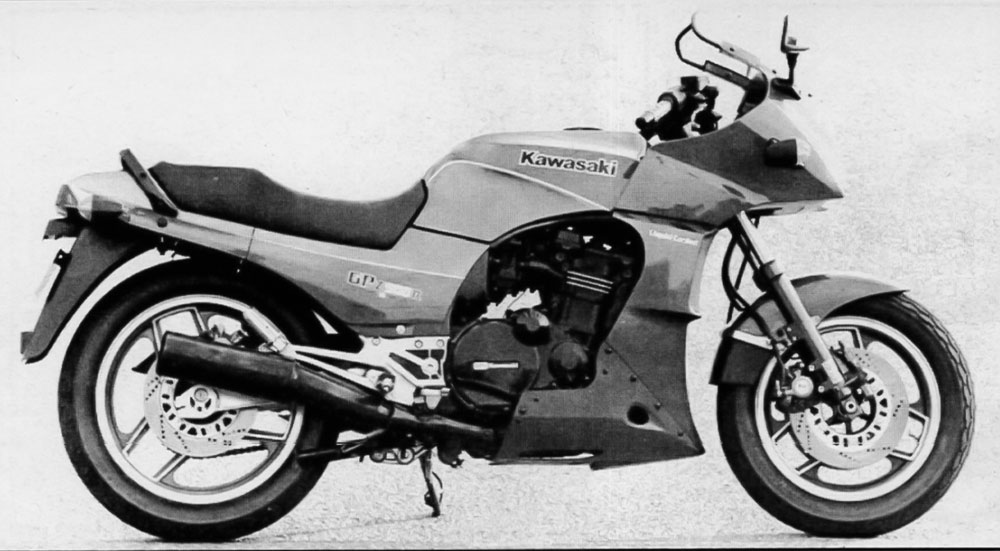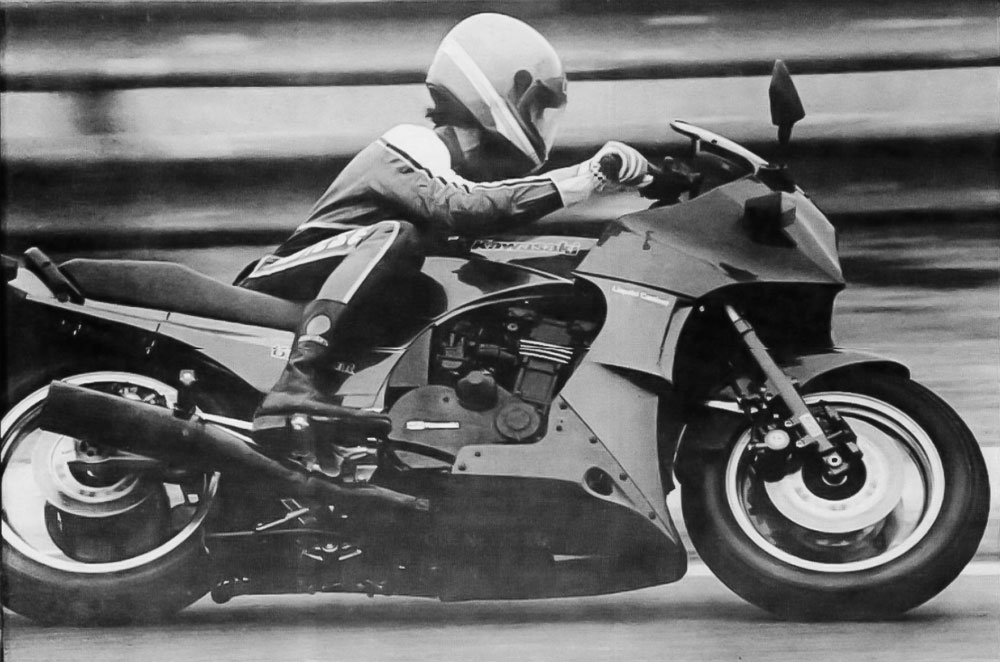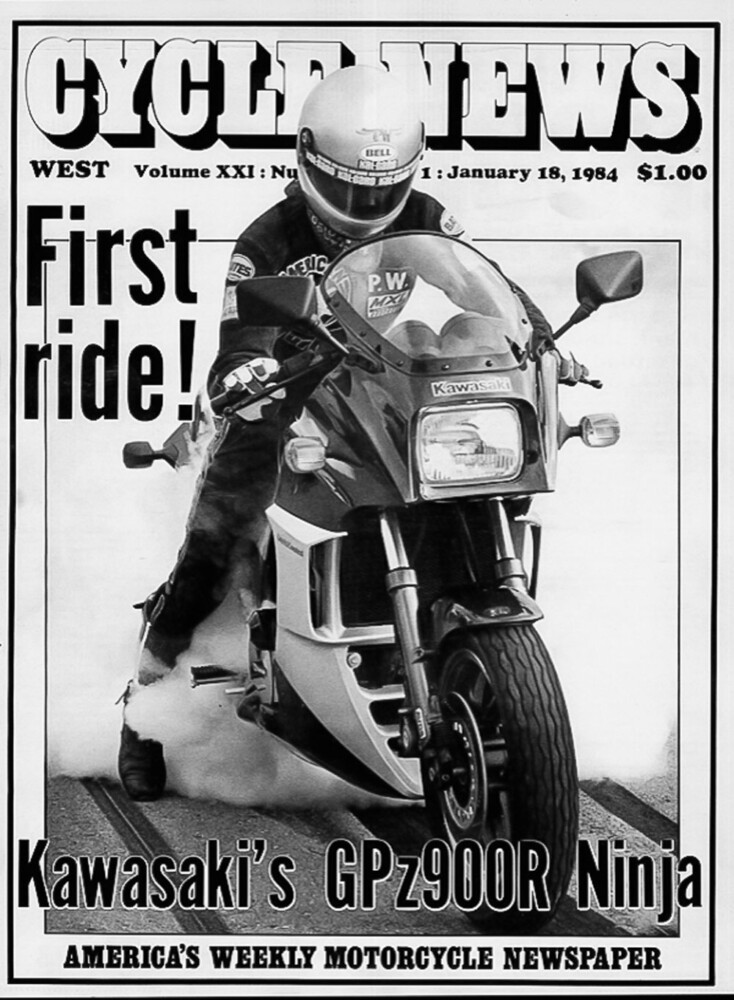Archives Column | 1984 Kawasaki Ninja GPz900R
Kit Palmer | November 12, 2023
Cycle News Archives
COLUMN
Enter The Ninja
By Kit Palmer
Kawasaki is about to celebrate the 40th anniversary of its Ninja brand of motorcycles. The first Kawasaki motorcycle to adorn the Ninja moniker was the 1984 GPz900R. I remember that bike well.
 In 1984, Kawasaki unleashed the very first Ninja, the GPz900R.
In 1984, Kawasaki unleashed the very first Ninja, the GPz900R.
I had just joined the CN staff a few months before the launch of the GPz900R. I was the “dirt bike guy,” but the Ninja was one of those few street bikes that caught my attention then. Surprisingly, I even wanted to own one the moment I blasted through the bike’s six-speed transmission for the first time, just as I would have on a KX125. Oh, man! What a rush. I had never ridden anything like it before, and from what I could tell, despite my limited street biking experience, it seemed to do everything well, but what did I know? Well, I did know one thing: the Ninja was fast. Outrageously, fast! This was no KX125.
Unfortunately, I never bought one, even though, if I recall correctly, Kawasaki offered members of the media and industry a chance to purchase their own Ninja at a considerable discount. As tempting as that was, I didn’t take the bait. After all, dirt bike guys like me back then were usually broke.
 Kawasaki let the media loose on the Ninja for the first time at Laguna Seca.
Kawasaki let the media loose on the Ninja for the first time at Laguna Seca.
I, unfortunately, had nothing to do with our first test ride of the 1994 GPz900R Ninja. Instead, legendary photographer David Dewhurst penned our first riding impression of the Ninja, published in our January 18, 1984, edition of Cycle News. He attended the Ninja launch for us, which was held at Laguna Seca Raceway. I wanted to look back at that test and read what he had to say about that very first Ninja motorcycle. Here are some excerpts:
- Kawasaki engineers don’t hide the fact that they like performance. You need look no further back than to America’s original muscle bike, the 900cc Z-1, their 500cc two-stroke triple, or the latest bright red GPz1100 for proof of that. So, when those same engineers unveiled the all-new GPz900R there was no real doubt about the bike’s intended role. Kawasaki described the fully faired 900 as “… having the performance of an 1100 and the agility of a 750.”
- Two days of racing around Laguna Seca were enough to convince journalists from around the world that Kawasaki has created one of the fastest street-legal motorcycles that ever turned a wheel. That wasn’t much of a surprise, considering Kawasaki’s performance reputation.
- Had this been any other Japanese manufacturer, the GPz900R might have been powered by a V-4 motor and housed in a square-section tube frame. It might also have been controlled by a computerized brain and monitored by digital instruments. It isn’t. Instead, it’s powered by a motor with a time-honored inline-four configuration and doesn’t have anything much more exotic than a new design of Keihin carburetor. Don’t let this apparent simplicity fool you, though. What the GPz900R lacks in high-tech hardware it more than makes up for in down-to-earth performance. Everything about the all-new liquid-cooled inline four seems to have been crafted for speed. From its 16-inch front wheel to its concentric rear-axle adjusters, the latest GPz is a downsized rocket waiting to be launched.
 Pee Wee Gleason was pictured doing his thing on the Ninja in the CN issue that had our first ride review of the Ninja 900.
Pee Wee Gleason was pictured doing his thing on the Ninja in the CN issue that had our first ride review of the Ninja 900.
- When you ignite this red and gray beauty, a familiar inline-four-cylinder motor roars into life. But that is where any similarities between this and any previous Kawasaki motor end.
- Around Laguna Seca’s sweeping high-speed turns, the 900 would, just as the excited engineers had predicted, easily stay with and sometimes outhaul both the 1100 and Turbo. And unlike both its peakier stablemates, the new 900R could be pushed harder on the exit of turns without fear of a sudden rush of power breaking the rear wheel loose. And in the less-predictable world of canyon racing, that should prove to be a real advantage.
- The entire [chassis] does not appear to offer much rigidity, but one fast lap of Laguna Seca proved that Kawasaki has produced a chassis that others will probably be judged by. The GPz900R can be best described as having the taut feel of a road racer, an attribute rarely present in road-going motorcycles. As a result, the new Kawasaki can be pushed hard over bumps and ripples without a weave or wobble. The same could not be said for the GPz1100 and 750 Turbo under the same conditions.
- Just sitting on the bike and compressing the suspension gives no indication of how well the system works.
- At speed, the riding position felt very good, but many Americans will probably want less of a European crouch while they cruise the superslab. But whatever the 900R lacks in a ride-to-work riding position, it more than makes up for in what Americans love best: Horsepower. It’s a red rocket in true Kawasaki tradition.
That said, Mr. Dewhurst apparently enjoyed the Ninja GPz900R as much as I did.CN